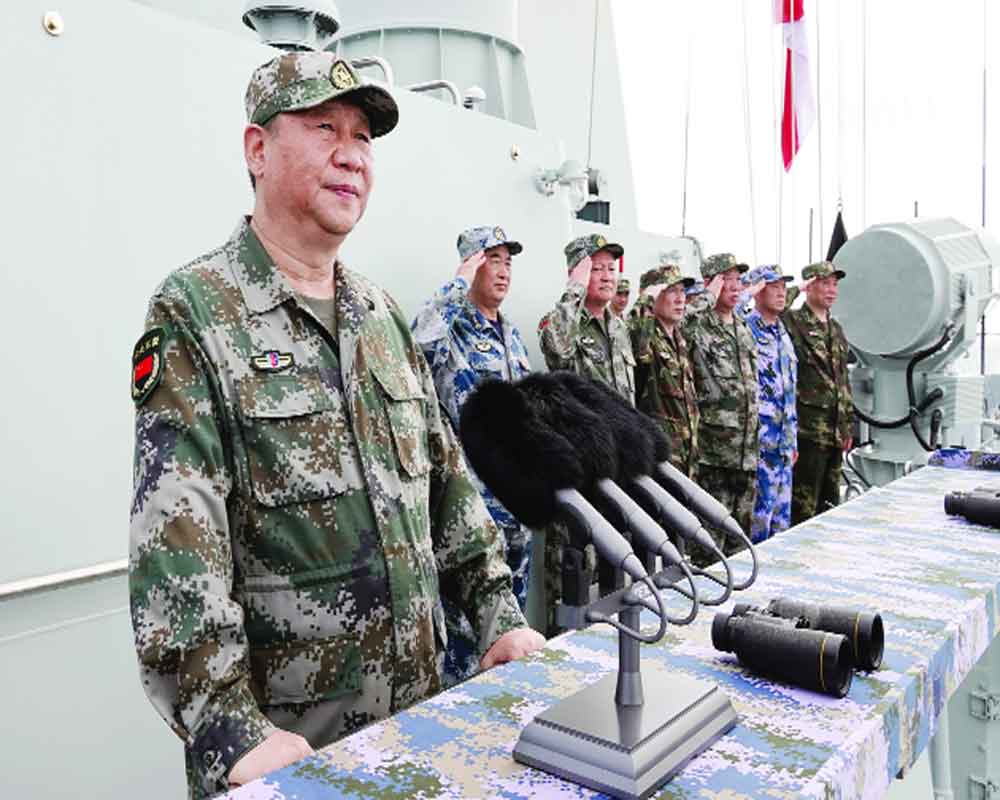Like its economic juggernaut that has apparently ‘overheated’, China’s diplomatic-military assertions and bellicosity by the PLA are more about posturing than the bite
The Chinese use a term ‘xuanchuán’, which literally means propaganda — an intrinsic tact of the Communist Party of China (CPC) to legitimise various state actions and to posture a certain inevitable destiny, muscularity and invincibility among all stakeholders, domestically and externally. The Chinese leadership often teases and releases unverifiable information about its military preparedness and technological advancements. The deliberate sneak-peak of the fifth generation stealth fighter plane J-20, nuclear submarines, aircraft carrier programme and cruise missiles among others are all a part of the intimidation and muscle-flexing exercise. A carefully calibrated media environment advances a narrative of the next-generation capabilities like hypersonic weaponry, cyberwarfare and an overall security framework that entails the most advanced ‘anti-access/area-denial’ military doctrines (A2/AD). This perception of the People’s Liberation Army’s (PLA) capability (entailing ground forces, Navy, Air Force, rocket force and strategic support force) then supports the more political and diplomatic aggression that the Chinese leadership indulges on its expansionist agenda in Taiwan and South China Sea belligerence. This sense of ‘war-clouds’ was implicit in the Chinese President Xi Jinping’s first order of 2019 to the PLA, where he stated, “All military units must correctly understand major national security and development trends and strengthen their sense of unexpected hardship, crisis and battle”.
Undeniably, the PLA is the largest military force in the world (two million active strength) with the second largest defence budget of $175 billion, annually. This is nearly four times that of India ($45 billion) and it grew at an unprecedented rate of eight per cent over the previous year. This generous outlay was possible due to the Chinese economic juggernaut that affords the indulgences of the interlinked diplomatic-military Chinese footprint across the globe and funds crucial investments for the PLA’s modernisation and technology development. Yet, military analysts are not entirely convinced of the PLA’s battle-preparedness.
For starters, the PLA is still technically a ‘party Army’ and is given to distractive and time-consuming indoctrination sessions at all operational levels by political officers of the CPC. While all career officers of the PLA are CPC members, the apex decision-making body for the PLA is drawn from the communist party committees that are dominated by civilian party members and ideologues, as opposed to career military men. The state is forever paranoid about regime-change (especially after the Tiananmen Square incident), and, therefore, the top brass of the PLA is firmly reined in under the party directive that could affect serious soldiering, culture and professional efficacy.
The second major concern is the operational ‘jointsmanship’ among various serving arms of the PLA as that requires a coordinated fighting capability, responsive command system, logistical/maintenance framework and inter-service interlinkages for a seamless operation — these shortcomings have been routinely pointed out and internally accepted with concerted efforts being made to overcome the same. The days of Chinese ‘human wave attacks’ a la 1962 are passé, and the Gulf Wars of the 1990s exposed the hollowness of simple ‘numeric superiority’ and ‘ideological armies’ as opposed to professional soldiering. Islands of technological advancements and advanced weaponry need to coincide with the requisite skills, training and handling experience of effectively deploying the same under combat-stress situations by the soldiers.
Unlike most major militaries (the US, NATO, Russia and India among others) that have partaken in the invaluable and irreplaceable experience of combat operations, the Chinese PLA remains the most combat-inexperienced major military in the world. All four key elements of war — soldiering, leadership, weaponry and doctrines — are posited on conjecture and untested claims. The last major combat for PLA was 40 years ago against Vietnam, where the ostensibly inferior Vietnamese forces inflicted a serious blow to the bungled Chinese invasion.
Earlier still, and contrary to 1962, the Sino-Indian clashes at Cho La and Nathu La in 1967 had resulted in a bloody nose for the PLA. Purely from the time perspective, that leaves virtually no one in the active PLA with any battle experience. Despite breathing fire on Taiwan, Japan or incidents like Doklam, the PLA has not secured any tangible ground on the ‘enemy’. In comparison, the US has been involved in the Middle East and Afghanistan in recent times, the Indian (and Pakistani) forces have had Kargil and multiple domestic insurgencies that have consistently tested their ‘software’ and ‘hardware.’ The US has tested its prime weaponry like the GBU-43/B (‘mother of all bombs’) in Afghanistan, its F-22 Raptor stealth fighter jets in ‘combat surges’ over Syria, as reportedly have the Russians, who deployed their SU-57 stealth fighter prototypes. Vladimir Shamanov, the Russian Duma’s Defence Committee head, has claimed that Russia has tested ‘over 200 new weapons’ in Syria. Whereas, the efficacy of advanced Chinese weaponry is a matter of pure claims by Beijing.
The PLA is undoubtedly undergoing a major overhaul and investment in terms of material upgradation, training and integration. However, all these investments are predicated on the continuing ‘bull run’ of the Chinese economy — dark clouds of an economic slowdown loom and China has recorded its slowest growth rate since 1990. The inevitable US-China trade wars, too, will take their own toll and can trigger unfathomable headaches for the CPC to manage. This could usher in a revised set of priorities (for example, cuts for PLA and defence industry) for the CPC in order to keep the more important lid on its restive masses from questioning the regime during an economic downturn. The famed ‘cheque-book’ diplomacy to ‘buy out’ sovereign loyalty, for example CPEC, Djibouti or Philippines, could also become an immediate casualty. Lastly, the recent Chinese belligerence has led to the emergence of powerful counter-opposition to checkmate China’s ambitions. The ‘Quad’ (US, Japan, Australia and India) is also symptomatic of the strategic evolution that works to the detriment of the Chinese. Perhaps like its economic juggernaut that has apparently ‘overheated’, China’s diplomatic-military assertions and bellicosity by the PLA are a lot more about posturing than it can realistically sustain or ‘bite’. It will remain the cynosure for the US, and to that extent, the saber-rattling by the Chinese PLA is here to stay. A closer analysis, however, leaves a lot of unanswered questions on its battle preparedness.
(The writer, a military veteran, is a former Lt Governor of Andaman & Nicobar Islands and Puducherry)


























